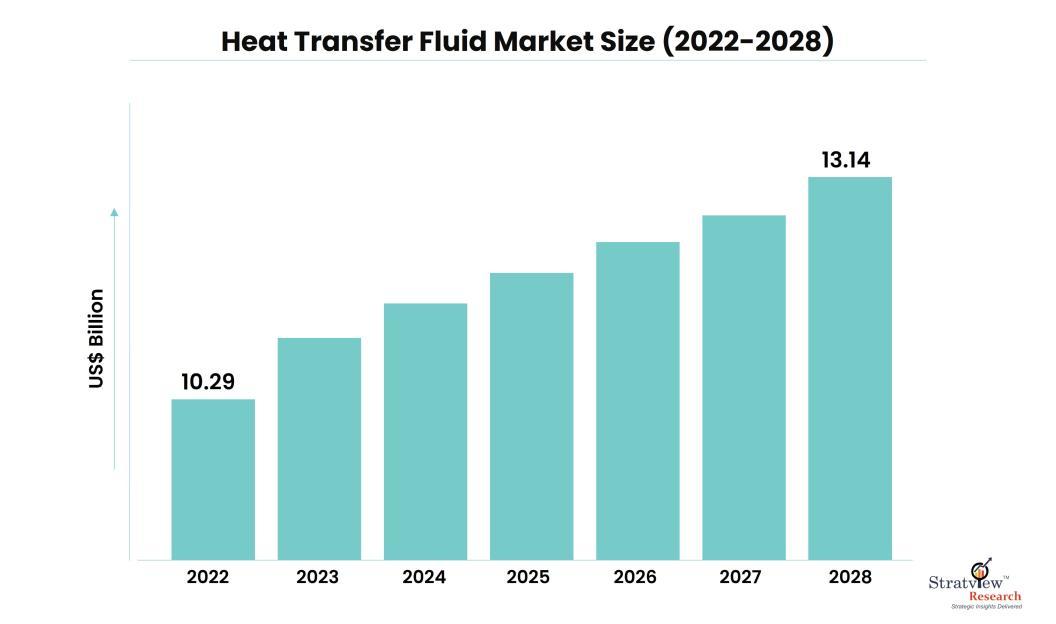The future of heat transfer fluid market: A look at emerging trends and technologies.

Heat transfer fluids are essential components in a wide range of industrial and commercial applications. According to a report by Straview Research, the heat transfer fluid market is estimated to grow from USD 10.29 billion in 2022 to USD 13.14 billion by 2028 at a CAGR of 4.10% during the forecast period. They are used to transport heat from one location to another and play a critical role in maintaining efficient and safe operations. The global heat transfer fluid market is expected to grow significantly in the coming years, driven by factors such as the increasing demand for energy efficiency, the expansion of renewable energy generation, and the growth of emerging industries such as electric vehicles.
Emerging trends in the heat transfer fluid market
A number of emerging trends are shaping the future of the heat transfer fluid market. These trends include:
· Growing demand for sustainable and environmentally friendly heat transfer fluids: Traditional heat transfer fluids, such as mineral oils and synthetic hydrocarbons, can have a negative impact on the environment. As a result, there is a growing demand for sustainable and environmentally friendly heat transfer fluids. This is driving the development of new heat transfer fluids based on renewable and biodegradable materials.
· Increasing use of heat transfer fluids in renewable energy applications: Renewable energy technologies such as concentrated solar power (CSP) and geothermal energy rely on heat transfer fluids to transport heat from the source to the point of use. The growth of the renewable energy sector is expected to boost the demand for heat transfer fluids.
· Rising demand from emerging markets: Emerging markets such as China, India, and Brazil are experiencing rapid economic growth. This is leading to increased demand for heat transfer fluids from a variety of industries, including chemicals, petrochemicals, food and beverage, and power generation.
Emerging technologies in the heat transfer fluid market
In addition to the emerging trends mentioned above, a number of emerging technologies are also having a significant impact on the heat transfer fluid market. These technologies include:
· Nanofluids: Nanofluids are heat transfer fluids that contain suspended nanoparticles. Nanoparticles can significantly improve the thermal conductivity of heat transfer fluids, making them more efficient at transferring heat.
· Phase change materials (PCMs): PCMs are materials that absorb and release heat as they change phase. PCMs can be used to store thermal energy and release it gradually over time. This can be useful in applications where heat needs to be stored and transported for extended periods of time.
· Self-healing heat transfer fluids: Self-healing heat transfer fluids are able to repair themselves automatically when they are damaged. This can help to extend the lifespan of heat transfer fluids and reduce maintenance costs.
Impact of emerging trends and technologies on the heat transfer fluid market
The emerging trends and technologies mentioned above are expected to have a significant impact on the heat transfer fluid market in the coming years. The growing demand for sustainable and environmentally friendly heat transfer fluids is expected to lead to the development and adoption of new heat transfer fluids based on renewable and biodegradable materials. The increasing use of heat transfer fluids in renewable energy applications is also expected to boost the demand for heat transfer fluids.
Emerging technologies such as nanofluids, PCMs, and self-healing heat transfer fluids are also expected to have a major impact on the heat transfer fluid market. These technologies can offer significant advantages in terms of efficiency, performance, and lifespan. As a result, they are expected to be adopted by a wider range of industries in the coming years.
Additional insights
In addition to the trends and technologies mentioned above, there are a number of other factors that are expected to shape the future of the heat transfer fluid market. These factors include:
· Government regulations: Governments around the world are increasingly enacting regulations aimed at reducing greenhouse gas emissions and protecting the environment. These regulations are expected to drive the demand for sustainable heat transfer fluids.
· Advances in manufacturing: Advances in manufacturing technologies are leading to the development of new and more cost-effective heat transfer fluids. This is making heat transfer fluids more accessible to a wider range of industries.
· Growing awareness of the benefits of heat transfer fluids: More and more businesses are becoming aware of the benefits of using heat transfer fluids, such as improved energy efficiency, reduced maintenance costs, and extended equipment lifespan. This is increasing the adoption of heat transfer fluids in a wider range of applications.
Conclusion
· The future of the heat transfer fluid market is bright. The market is expected to grow significantly in the coming years, driven by factors such as the increasing demand for energy efficiency, the expansion of renewable energy generation, and the growth of emerging industries such as electric vehicles. The emerging trends and technologies mentioned above are expected to have a major impact on the market, leading to the development and adoption of new, more efficient, and more sustainable heat transfer fluids.
- Art
- Causes
- Crafts
- Dance
- Drinks
- Film
- Fitness
- Food
- Spiele
- Gardening
- Health
- Startseite
- Literature
- Music
- Networking
- Andere
- Party
- Religion
- Shopping
- Sports
- Theater
- Wellness
- IT, Cloud, Software and Technology


